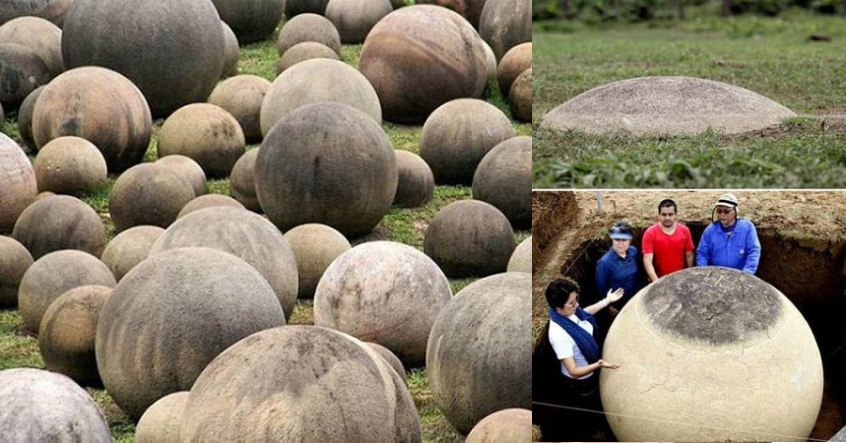The stone spheres of Costa Rica are one of the most intriguing and enigmatic archaeological finds in Central America. Discovered in the Diquís Delta region, these perfectly spherical stones, some weighing up to 16 tons, raise a multitude of questions about the capabilities of ancient civilizations and the purpose behind their creation. Despite being tangible artifacts, the origins of these stones remain shrouded in mystery. Who created them, and why? And how could such a precise geometric feat have been achieved with the primitive tools available at the time?
The Stones: An Ancient Enigma
The Costa Rican stone spheres are not mere folklore; they are real, physical objects that exist today, still scattered across the region. Many of them display extraordinary precision, with some measuring up to 2.66 meters in diameter. This near-perfect spherical geometry has captivated archaeologists and historians for decades. What’s more, the spheres are carved from a variety of materials, such as gabbro, a type of granite, suggesting that the creators possessed a deep understanding of local geology and craftsmanship.
However, these objects present a problem for conventional archaeological dating methods. The spheres are made of stone, which cannot be dated using radiocarbon dating, a technique that is effective only on organic materials. Any potential organic remnants that may have once existed on or near the spheres would have been washed away or eroded over time. As a result, their exact age and the civilization that created them remain uncertain.

The Diquís Culture: Builders of the Spheres
Archaeological evidence links the stone spheres to the Diquís culture, which flourished in the region between 600 and 1500 AD. This society, while advanced in many ways, was considered “primitive” in comparison to the monumental civilizations of Egypt or Mesopotamia. Yet, the ability to carve such large, geometrically precise stones challenges this assumption. Some spheres are so large that their weight and size would make them incredibly difficult to shape without advanced tools and methods. The sheer number of spheres—hundreds have been discovered—suggests that they held a significant place in the society that created them.
This raises an interesting question: how could a society, considered by some to be “primitive,” possess the technical skill to create such perfect spheres? Could they have had access to lost knowledge or techniques that have since been forgotten? The precision involved in crafting these stones suggests a level of expertise in geometry and stoneworking that was not common in ancient cultures.

The Origins of Human Civilization: A Complex Tapestry
The mystery of the stone spheres becomes even more perplexing when we consider the broader context of human civilization in the Americas. The Clovis culture, once thought to be the first to inhabit the Americas around 14,000 years ago, has recently been challenged by new evidence that suggests human activity in central Mexico as far back as 30,000 years. Genetic studies also point to migrations from Sundaland (modern-day Southeast Asia) and Siberia, indicating a much more complex and far-reaching history of human migration than previously understood.
Given this new understanding of early human history, it is possible that the stone spheres are part of a much larger pattern of advanced cultural development in the Americas. Could the Diquís culture have been influenced by or even connected to other ancient civilizations with similar technological capabilities? The idea that these civilizations may have shared knowledge or even interacted is an exciting prospect, but it remains speculative without concrete evidence.

The Purpose of the Spheres: Symbols or Tools?
The purpose of the stone spheres remains one of the most hotly debated topics among archaeologists. Their concentration in a small area suggests that they were important cultural or ceremonial objects. Were they used for astronomical purposes, perhaps as markers for celestial events? Or were they symbols of power, representing the status of the elite or serving as territorial markers? Some have even proposed that the spheres had a religious or ritual significance, though no definitive proof exists.
One thing is clear: the sheer number and size of the spheres indicate they were more than mere decorative objects. They likely had a function that was deeply intertwined with the cultural and religious life of the Diquís people. However, without written records or further evidence, their true purpose may never be fully understood.
Conclusion: A Silent Legacy
The mystery of the stone spheres of Costa Rica continues to captivate researchers and visitors alike. These enigmatic objects stand as a testament to the craftsmanship and ingenuity of the ancient civilizations that created them. While the exact origins and purpose of the spheres remain unknown, they challenge our assumptions about ancient cultures and their capabilities. Far from being the creations of a “primitive” people, these spheres suggest a much more sophisticated understanding of geometry, technology, and culture.
As modern science continues to probe the secrets of the past, the stone spheres will undoubtedly remain a symbol of the complexity and mystery of ancient civilizations, inviting us to rethink the history of human achievement and the legacy of those who came before us.
